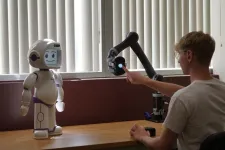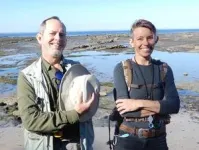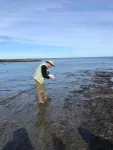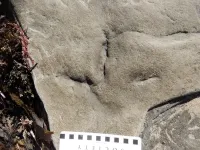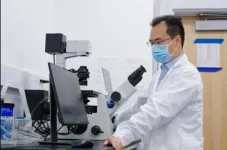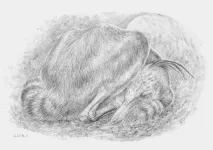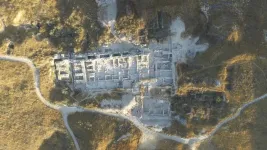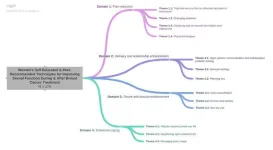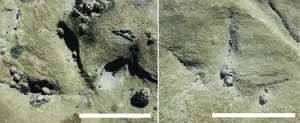(Press-News.org) Embargoed: Not for Release Until 2:00 pm U.S. Eastern Time Wednesday, 15 November 2023
Stroke is a leading cause of long-term disability worldwide. Each year more than 15 million people worldwide have strokes, and three-quarters of stroke survivors will experience impairment, weakness and paralysis in their arms and hands.
Many stroke survivors rely on their stronger arm to complete daily tasks, from carrying groceries to combing their hair, even when the weaker arm has the potential to improve. Breaking this habit, known as “arm nonuse” or “learned nonuse,” can improve strength and prevent injury.
But, determining how much a patient is using their weaker arm outside of the clinic is challenging. In a classic case of observer’s paradox, the measurement has to be covert for the patient to behave spontaneously.
Now, USC researchers have developed a novel robotic system for collecting precise data on how people recovering from stroke use their arms spontaneously. The first-of-its-kind method is outlined in a paper published in the November 15 issue of Science Robotics.
Using a robotic arm to track 3D spatial information, and machine learning techniques to process the data, the method generates an “arm nonuse” metric, which could help clinicians accurately assess a patient’s rehabilitation progress. A socially assistive robot (SAR) provides instructions and encouragement throughout the challenge.
“Ultimately, we are trying to assess how much someone’s performance in physical therapy transfers into real life,” said Nathan Dennler, the paper’s lead author and a computer science doctoral student.
The research involved combined efforts from researchers in USC’s Thomas Lord Department of Computer Science and the Division of Biokinesiology and Physical Therapy. “This work brings together quantitative user-performance data collected using a robot arm, while also motivating the user to provide a representative performance thanks to a socially assistive robot,” said Maja Matarić, study co-author and Chan Soon-Shiong Chair and Distinguished Professor of Computer Science, Neuroscience, and Pediatrics. “This novel combination can serve as a more accurate and more motivating process for stroke patient assessment.”
Additional authors are Stefanos Nikolaidis, an assistant professor of computer science; Amelia Cain, an assistant professor of clinical physical therapy, Carolee J. Winstein, a professor emeritus and an adjunct professor in the Neuroscience Graduate Program, and computer science students Erica De Guzmann and Claudia Chiu.
Mirroring everyday use
For the study, the research team recruited 14 participants who were right-hand dominant before the stroke. The participant placed their hands on the device’s home position—a 3D-printed box with touch sensors.
A socially assistive robot (SAR) described the system’s mechanics and provided positive feedback, while the robot arm moved a button to different target locations in front of the participant (100 locations in total). The “reaching trial” begins when the button lights up, and the SAR cues the participant to move.
In the first phase, the participants were directed to reach for the button using whichever hand came naturally, mirroring everyday use. In the second phase, they were instructed to use the stroke-affected arm only, mirroring performance in physiotherapy or other clinical settings.
Using machine learning, the team analyzed three measurements to determine a metric for arm nonuse: arm use probability, time to reach, and successful reach. A noticeable difference in performance between the phases would suggest nonuse of the affected arm.
“The participants have a time limit to reach the button, so even though they know they’re being tested, they still have to react quickly,” said Dennler. “This way, we’re measuring gut reaction to the light turning on—which hand will you use on the spot?”
Safe and easy to use
In chronic stroke survivors, the researchers observed high variability in hand choice and in the time to reach targets in the workspace. The method was reliable across repeated sessions, and participants rated it as simple to use, with above-average user experience scores. All participants found the interaction to be safe and easy to use.
Crucially, the researchers found differences in arm use between participants, which could be used by healthcare professionals to more accurately track a patient’s stroke recovery.
“For example, one participant whose right side was more affected by their stroke exhibited lower use of their right arm specifically in areas higher on their right side, but maintained a high probability of using their right arm for lower areas on the same side,” said Dennler.
“Another participant exhibited more symmetric use but also compensated with their less-affected side slightly more often for higher-up points that were close to the mid-line.”
Participants felt that the system could be improved through personalization, which the team hopes to explore in future studies, in addition to incorporating other behavioral data such as facial expressions and different types of tasks.
As a physiotherapist, Cain said the technology addresses many issues encountered with traditional methods of assessment, which “require the patient not to know they're being tested, and are based on the tester's observation which can leave more room for error.”
“This type of technology could provide rich, objective information about a stroke survivor's arm use to their rehabilitation therapist,” said Cain. “The therapist could then integrate this information into their clinical decision-making process and better tailor their interventions to address the patient's areas of weakness and build upon areas of strength."
END
Use it or lose it: New robotic system assesses mobility after stroke
A new robotic tool developed by USC researchers could help stroke survivors track their recovery progress.
2023-11-15
ELSE PRESS RELEASES FROM THIS DATE:
Birds set foot near South Pole in Early Cretaceous, Australian tracks show
2023-11-15
The discovery of 27 avian footprints on the southern Australia coast — dating back to the Early Cretaceous when Australia was still connected to Antarctica — opens another window onto early avian evolution and possible migratory behavior.
PLOS ONE published the discovery of some of the oldest, positively identified bird tracks in the Southern Hemisphere, dated to between 120 million and 128 million years ago.
“Most of the bird tracks and body fossils dating as far back as the Early Cretaceous are from the Northern Hemisphere, particularly from Asia,” says Anthony Martin, first ...
University of Kentucky bioengineer designs tools to improve treatment for head and neck cancer
2023-11-15
LEXINGTON, Ky. (Nov. 15, 2023) — One University of Kentucky researcher is working to develop new techniques for radiation treatment to improve survival rates of patients with a specific type of cancer.
Caigang Zhu, Ph.D., is an assistant professor in the Department of Biomedical Engineering in the UK Stanley and Karen Pigman College of Engineering. He is also a member of the Molecular and Cellular Oncology Research Program at the UK Markey Cancer Center.
The National Institute of Dental and Craniofacial Research of ...
New plant hardiness map, used by gardeners nationwide and based on OSU climate data, unveiled
2023-11-15
CORVALLIS, Ore. – The U.S. Department of Agriculture today released its new Plant Hardiness Zone Map, the national standard by which gardeners can determine which plants are most likely to survive the coldest winter temperatures at a certain location.
The USDA describes the latest map, jointly developed by Oregon State University’s PRISM Climate Group and the USDA’s Agricultural Research Service, as the most accurate and detailed it has ever released.
PRISM, part of the OSU College of Engineering, stands for Parameter-elevation Regressions on Independent Slopes Model. The previous version of the plant hardiness map, also based ...
An engineered protein enhances memory
2023-11-15
Neuroscientists at the Faculty of Medicine and Surgery of the Catholic University, Rome, and the Fondazione Policlinico Universitario Agostino Gemelli IRCCS have genetically modified a molecule, the protein LIMK1, which is normally active in the brain, with a key role in memory. They added a "molecular switch" that is activated by administering a drug, rapamycin, known for its several anti-aging effects on the brain.
This is the result of a study published in the journal Science Advances, which involves the Catholic ...
New near-complete skeleton of a bird-like dinosaur is found in a position which suggests it slept like modern birds
2023-11-15
New near-complete skeleton of a bird-like dinosaur is found in a position which suggests it slept like modern birds
###
Article URL: https://journals.plos.org/plosone/article?id=10.1371/journal.pone.0293801
Article Title: A new alvarezsaurid dinosaur (Theropoda, Alvarezsauria) from the Upper Cretaceous Baruungoyot Formation of Mongolia provides insights for bird-like sleeping behavior in non-avian dinosaurs
Author Countries: Japan, Mongolia
Funding: Funding for this project was granted by Research Fellowships from the Japan Society for the Promotion of Science (JSPS 21J12938) (to KK) and Ami Koshimizu (Endless Glory Office Restart Co., Ltd.) (to KK). The funders had ...
Radiocarbon dating meets Egyptology and Biblical accounts in the city of Gezer
2023-11-15
New dates provide detailed insights into the timing of events in the ancient city of Gezer, according to a study published November 15, 2023 in the open-access journal PLOS ONE by Lyndelle Webster of the Austrian Academy of Sciences and colleagues.
Gezer is an ancient southern Levantine city, well known from Egyptian, Assyrian, and Biblical texts and associated with stories of power struggles and significant historical figures. It is also a rich archaeological site with abundant Bronze Age and Iron Age remains and with great potential for research into the daily lives of its denizens. Recent excavations at the site have uncovered a continuous stratigraphic ...
Women with breast cancer take sexual health into their own hands
2023-11-15
A third of users on a popular breast cancer support forum describe using peer-recommended or self-discovered techniques to improve sexual functioning, according to a study published November 15, 2023 in the open-access journal PLOS ONE by Christiana von Hippel from the Dana-Farber Cancer Institute and Harvard T.H. Chan School of Public Health, USA, and colleagues.
Over 75 percent of breast cancer survivors describe experiencing some degree of sexual dysfunction. Commonly prescribed interventions such as vaginal lubricants or numbing creams are only moderately ...
Australian footprints are the oldest known evidence of birds from southern regions
2023-11-15
Early birds had made it to southern polar environments by 120 million years ago, according to a study published November 15, 2023 in the open-access journal PLOS ONE by Anthony Martin of Emory University, USA and colleagues.
Cretaceous bird fossils are abundant and diverse in northern continents, but extremely rare in southern continents, regions that were once part of the landmass of Gondwana. This presents a challenge for paleontologists trying to understand the distribution of early birds. In this study, Martin and colleagues report ...
Treatment strategy for certain advanced prostate cancers shows promise in preclinical models
2023-11-15
Study Title: Targeting DNA methylation and B7-H3 in RB1-deficient and neuroendocrine prostate cancer
Publication: Science Translational Medicine [10.1126/scitranslmed.adf6732]
Dana-Farber Cancer Institute author: Himisha Beltran, MD
Summary: Epigenetic changes can cause prostate cancer to resist treatment by switching genes on or off. One epigenetic mechanism tags genes with DNA methylation marks. This process is mediated by molecules called DNA methyltransferases. These tags can alter gene expression in ways that promote tumors to grow and transition ...
Devil in the detail – What corporations aren’t disclosing about their C02 emissions
2023-11-15
A new study estimates most corporations are not reporting the full scope of their carbon footprint with many claiming to be ‘green’ despite a lack of reporting on Scope 3 key categories.
Though CO2 reporting is currently voluntary for most firms, corporations are under pressure from investors, regulators, politicians, non-profit organisations and other stakeholders to disclose and reduce greenhouse gas emissions (GHG).
The standard for greenhouse gas accounting, the Greenhouse Gas Protocol, is used worldwide to measure a company’s total carbon footprint with three levels of reporting.
The first measures the GHG emissions directly produced by a company ...
LAST 30 PRESS RELEASES:
Exploring how patients feel about AI transcription
Category ‘6’ tropical cyclone hot spots are growing
Video: Drivers struggle to multitask when using dashboard touch screens, study finds
SLU research shows surge in alcohol-related liver disease driving ‘deaths of despair’
Rising heat reshapes how microbes break down microplastics, new review finds
Roots reveal a hidden carbon pathway in maize plants
Membrane magic: FAMU-FSU researchers repurpose fuel cells membranes for new applications
UN Member States pledge to increase access to diagnosis and inhaled medicines for the 480 million people living with COPD
Combination therapy shows potential to treat pediatric brain cancer ATRT
Study links seabird nesting to shark turf wars in Hawai‘i
Legal sports betting linked to sharp increases in violent crime, study finds
Breakthrough AI from NYUAD speeds up discovery of life-supporting microbes
New Eva Mayr-Stihl Foundation funding initiative boosts research at University of Freiburg on adaptation of forests to global change
The perfect plastic? Plant-based, fully saltwater degradable, zero microplastics
Bias in data may be blocking AI’s potential to combat antibiotic resistance
Article-level metrics would provide more recognition to most researchers than journal-level metrics
Satiety’s little helper: Protein that supports appetite regulating protein identified
UF dives deep into predicting storm damage with computer models
A stormy ocean voyage yields insights on the global carbon cycle
Scientists identify first non-coding gene that controls cell size
Demonstration of altermagnetism in RuO₂ thin films -- A new magnetic material for the AI era
Penn researchers awarded $25M to conduct trial using smartphones to fight heart disease
PCORI awards funding for new patient-centered healthcare research
Exploring the origins of the universe: 145 low-noise amplifiers complete ALMA telescopes
Empress cicada wings help illuminate molecular structure
Using sound waves to detect helium
Time burden in patients with metastatic breast and ovarian cancer from clinic and home demands
Researchers discover bias in AI models that analyze pathology samples
Scientists ID potential way to prevent brain injuries from triggering Alzheimer's
MASTER 2nd Open Call: Execution period kick-off
[Press-News.org] Use it or lose it: New robotic system assesses mobility after strokeA new robotic tool developed by USC researchers could help stroke survivors track their recovery progress.
